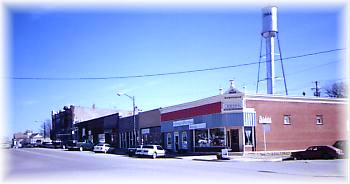
John Steuart Curry was born in 1897 and was raised on a farm six miles north of Oskaloosa. He completed the usual farm chores while attending school at Hickory Point. His artistic abilities soon caught the attention of his teacher.
By the time he was 12, he was taking formal drawing lessons at Oskaloosa from a Mrs. Alice Worswick who had studied in Paris. He attended high school at Winchester High School until, finding it a bore, he left school in 1916 to attend the Kansas City Art Institute. Later, he attended the Chicago Art Institute for two years and then studied for a short time at Geneva College in Pennsylvania. After this he moved to Tenafly, N.J., where he worked and studied independently under the illustrator Harvey Dunn. After service in the World War he returned to his art at the Art Students' League in New York. In 1926 Seward Prosser, a wealthy New York banker, made it possible for him to study for two years under Shoukhieff at the Russian Academy of Art in Paris. For the next two years he had the assistance of Mrs. Harry Payne Whitney, a generous patron of American art, and herself a sculptress of considerable ability.
The name of John Steuart Curry was almost unknown in Kansas before 1930, and very few outside of art circles were acquainted with his work. In 1933, he was ranked among the foremost contemporary American artists by inclusion of his painting, Baptism in Kansas, at the art exhibit held in the Chicago Art Institute during the World's Fair.
Curry's best known painting of John Brown in the Kansas Capitol depicts Brown more as a character from the Old Testament than a figure from American history. The figure of heroic size is shown grasping a Holy Bible in one outstretched hand and a "Beecher's Bible" in the other. The wrath of God is depicted by a tornado painted into the background behind Brown and the just cause for which he fought is represented by the head of a Negro in the foreground. Because of an altercation with the Kansas Legislature, the painting was not finished and remains unfinished to this day.
Curry's paintings, "Western Migration" and "Justice Defeating Mob Violence," were done for the Department of Justice. Curry did not paint for the private collector but instead for the public. Most of his paintings are large and intended for museums or other public places where viewers can gain from them the spirit and feelings for the country he depicted.
How faithfully he has done his work cannot be determined without due consideration of the artist's motives, his sincerity of purpose and his inherent right of the use of emphasis perhaps even to the extent of distortion, by which he may seek to convey his message of truth.
Curry lived in Westport, CT., until 1936 when he was offered the position of Artist in Residence at the Agricultural College at the University of Wisconsin. He stayed there until his death in 1946.
